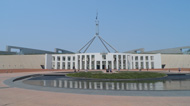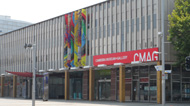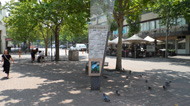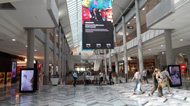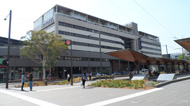Canberra bus station |
Hotel Kurrajong***** |
The Parliament in Canberra |
Entrance to the Parliament |
Canberra |
Unlike the main Australian cities that sprang up on the coasts, at the landing points of the first settlers, Canberra was built inside the country. It has a population of about 410,000, and is the federal capital, which was built starting in 1923, to end the dispute between the country's two major cities, Sydney and Melbourne, which both aspired to become capital. Located on the Molonglo River, it stands on the banks of an artificial lake, the Burley Griffin, in a predominantly agricultural region. An extremely modern city, Canberra is the political and administrative center of the country. Much of the local population is employed in the public sector, but the tourism and light industry sectors are also expanding. Noteworthy buildings are the new Parliament, inaugurated in 1988, the fountain with the Cook monument, in Lake Burley Griffin, the National Library (1968) and the Australian National Gallery (1982). Among the various educational and academic institutions, we remember the Australian National University (1946). The first settlements of the Europeans in this area date back to 1824. In 1908 the sparsely populated area was chosen to host the capital of Australia. The American architect Walter Burley Griffin won an international competition to design the new city. Construction began in 1913, was interrupted by the outbreak of the First World War and completed in the 1920s. The parliament, which had been in Melbourne since 1901, was moved to Canberra in 1927. The Canberra National Library houses the original drawings of the Sydney Opera House. As the seat of the Australian government, Canberra is home to Parliament, the High Court of Australia and numerous other government institutions. It is also home to numerous social and cultural organizations of national importance. The federal government contributes most of the city's gross domestic product and is Canberra's largest employer. Before the European settlement, the area on which Canberra stands today was inhabited by the Aboriginal peoples Ngunnawal and Walgalu, bordering the Ngarigo in the southeast, the Gundungurra in the north, the Yuin on the coast and the Wiradjuri in the west. Archaeological tests show, for the Canberra area, a housing continuity of at least 21,000 years. The name "Canberra" derives both from the English name of the locality Canberry and from the word Ngunnawal Kambera, which means "meeting place". The name Ngunnawal seems to refer to the fact that the area hosted a corroboree, a recurring ceremony, held during the seasonal migration of the Ngunnawal to celebrate the spring transit of the swarms of Bogong butterflies. European exploration and colonization of the area began around 1820 and the region was affected by four exploratory expeditions between 1820 and 1824. The first European settlement in the area probably dates back to 1824, when some breeders employed by Erik Sigleish built an inn on what is now known as the Acton Peninsula. Sigleish formally purchased the farm in 1826 and named the "Canberry" estate. The European population grew slowly during the XIXth century, while the native population decreased, also due to measles and chicken pox. Over fifty years the indigenous population was almost completely assimilated into European culture, even through mixed marriages. The transition from rural New South Wales to national capital began during the discussions on the establishment of the Australian federation in the late XIXth century. At the end of a long dispute that saw Sydney and Melbourne opposed in the role of pretenders to the title of capital, a compromise was reached: Melbourne would have been interim capital, while a new capital would have been built in the area between the two cities. The Canberra site was chosen in 1908 as a result of a governmental investigation conducted by Charles Scrivener. The government of New South Wales ceded the area, which became the Federal Capital Territory, to the federal government on January 1, 1910; in the following year the federal government organized an international competition for the design of the city. Walter Burley Griffin's project was chosen in 1913, Griffin was appointed general manager of the works and construction began. The name of the city was officially assigned by Lady Denman (Nata Gertrude Mary Pearson), wife of the Governor General of Australia, Lord Thomas Denman, during a ceremony held on March 12, 1913 in Kurrajong Hill, since then Capital Hill and current site on which stands the Australian Parliament building. Canberra Day, the anniversary of the foundation, is a regional public holiday of the Australian Capital Territory, which falls on the second Monday of each March. The federal government took office in Canberra on May 9, 1927, with the opening of the provisional parliament. A few days ago the prime minister, Stanley Bruce, had entered the new residence: "The Lodge". In 1928 the current coat of arms of the city was adopted, whose original motto in Latin "pro rege lege et grege" we can translate as "for the king, the law and the people", with the Australian black swan representing the Aboriginal population and the European swan the colonists, placed as supports to the shield of the coat of arms, symbolically to the capital. The construction and population of the capital continued in its final phase alongside the works for the construction and launching of the homonymous cruiser, HMAS Canberra (D33), with whom he also shared the coat of arms and the motto. The development of the city was significantly slowed by the economic depression of the 1930s and the Second World War. Some of the plans planned for the time, such as the construction of the Anglican and Catholic cathedrals, were never completed. Canberra's development picked up after World War II, leading to growth that surpassed the initial project's predictions. On January 27, 1972 the Aboriginal Tent Embassy, ??the "tent of the Aboriginal embassy", was created at the bottom of the steps of parliament, created to pay attention to the rights of Australian native peoples and to land ownership issues. On 9 May 1988 a new definitive parliament building was inaugurated on Capital Hill, on the occasion of Australia's bicentennial celebrations. The federal parliament has since moved to the new location; the temporary parliament is now known as "the old parliament". In December 1988, Australian Capital Territory was granted full autonomy through a law of parliament which made it a political entity directly dependent on the British crown. The first regional elections, held in February 1989, led to the election of a 17-member legislative assembly which took office on 11 May 1989 at the London Circuit Civic venue. The majority of the assembly went to the Australian Labor Party and its prime minister, Rosemary Follett, entered Australian history as the first woman to head a regional government.
Canberra occupies an area of ??805 kmē and is located near the Brindabella mountain range, about 150 km away from the Australian east coast. Its altitude is between 550 and 700 meters above sea level. Its highest point is Mount Taylor, one of the broad hills of the group which also includes the Ainslie, Mugga and Black Mountain mountains. The surrounding woods and the forest on which Canberra was originally built are a combination of eucalyptus savannah, scrubland, swamp and eucalyptus forest. The Molonglo River flows through Canberra and has been harnessed in dams to form the lake located in the city center, Lake Burley Griffin. The Molonglo then flows into the Murrumbidgee north-west of the city, which flows along the south-western outskirts of Canberra. The Queanbeyan River flows into the Molonglo in the resort of Oaks Estate, just within the region's borders. Molonglo and Murrumbidgee collect the waters of numerous smaller rivers, including the Jerrabomberra and Yarralumla. Two of these, the Ginninderra and the Tuggeranong, were in turn barred by dams to form artificial basins. Until recently, the Molonglo river has a history of sometimes deadly floods, the same plain now occupied by the lake was an alluvial plain. Due to its position in the hills and the distance from the coast, unlike the other large Australian cities whose climate is mitigated by the proximity of the sea, Canberra has four distinct seasons. It is known for its hot and dry summers and foggy winters with frequent frosts. The car is the main form of transportation in Canberra; the city has a good road network and the population is distributed over a relatively large area. Compared to other Australian capitals, urban traffic in Canberra is flowing; traffic jams are rare and typical peak hour congestions generally do not last more than twenty minutes. The districts of Canberra are connected by parkways, high-flow dual carriageways, on which there is a speed limit of 80 km/h or 90 km/h. Canberra is located about three hours 'drive from Sydney along the Federal Highway, which connects to the Hume Highway (highway number 23) near Goulburn, and about seven hours' drive from Melbourne along the Barton Highway (highway number 25), which connects to the Hume Highway near Yass. From Sydney you can reach Canberra by bus in 3 and a half hours. Murrays departs from Sydney's Pitt Street railway station and arrives at the bus station located near the Novotel in Canberra. The ticket costs AU$ 74, round trip. The hotel booked was the Kurrajong, located in Barton, about 4 km from the center. The bus ticket costs AU$ 5. The town of Barton has nothing to offer, the hotel is a 10-minute walk from Parliament. In the evening, but also during the day there is no one around, it looks like a ghost town. It lacks of restaurants and bars. Only a few hotels with a restaurant attached. Two days are more than enough to visit Canberra (Parliament and city center).


